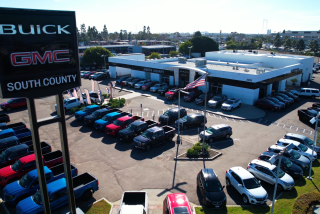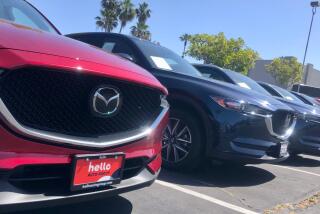Total Car Sales in U.S. During ’86 Set Record
DETROIT — American consumers bought more cars in 1986 than in any other year in history, the auto industry reported Wednesday.
Buoyed by discount-financing promotions, changes in the federal tax laws that gave consumers an incentive to buy in 1986 rather than in 1987 and a rising tide of imports from Japan and the Third World, total U.S. car sales hit a record of 11,442,663, the auto makers said.
That total, which was up 3.7% from the 1985 level, edges out the previous record for combined import and domestic sales of 11,435,989 set in 1973.
Imports led the way to the new overall record, with sales of foreign-built cars hitting a new high of 3,228,000 units for the year, up 13.9% from 1985.
With the addition of newly imported cars from South Korea and other Third World countries, total import sales volume in 1986 broke through the 3-million unit level for the first time.
The imports’ share of the U.S. market hit a record 28.2%, jumping nearly three percentage points from 1985’s level.
The biggest spur to import sales came from South Korea’s Hyundai, which set a record in 1986 for the most sales ever by an importer in its first year in the American market.
Hyundai sold 168,882 of its small and inexpensive Excel subcompacts, quickly establishing Hyundai as the sixth-largest importer in the United States. Most of the other major importers also reported strong gains.
Domestic sales, meanwhile, were relatively strong as well, thanks in part to the discount financing programs Detroit offered in the fall to clean out its bulging inventories of unsold cars.
Sales also boomed in late December, as buyers sought to make their purchases before the start of 1987, when the federal tax deduction for sales taxes on big-ticket items was erased by the new tax law.
“Sales last year were inflated by two things--incentives and the buy-in-advance effort to beat tax reform,” said Ted Sullivan, a sales analyst with Chase Econometrics, an economic forecasting firm.
But Sullivan and other analysts are now predicting that domestic sales will be weaker in the first quarter of 1987, since so many potential car buyers were “pulled ahead” into 1986 by the tax changes. “We’re still expecting a fairly strong 1987, but the first quarter should be light because of the tax pull,” said Chris Cedergren, sales analyst with J. D. Power & Associates, an automotive market research firm.
The domestic sales strength in 1986 also reflected the explosive growth of Japanese car production in the United States. Sales of U.S.-built models, including those Japanese cars assembled in this country, rose by a slight 0.1% to 8,214,663 units.
It was the domestic industry’s best showing since 1979, when sales hit 8,226,783 units, but the 1986 numbers include nearly 300,000 Japanese cars built in the United States.
Honda said it sold 235,247 U.S.-built cars, up 61.2% from 1985; Nissan reported a 32.2% jump, while Toyota began building cars in the United States for the first time during 1986.
Honda’s big lead in U.S. production over its Japanese rivals helped it become the No. 1 Japanese nameplate in America, surpassing Toyota for the first time in 1986. Honda sold a total of 693,515 U.S.- and Japanese-built cars here last year, compared to Toyota’s combined total of 641,087.
But for the traditional domestic companies, 1986 sales were relatively flat. General Motors, which has been struggling all year because of low consumer acceptance for many of its newest products, reported its sales fell 1.6% to 4,532,798 units.
And its share of the total car market, which has traditionally been well over 40%, dropped to 39.6% for the year.
Still, the best-selling nameplate in the industry was a GM product--the Chevrolet Celebrity, with sales of 408,946, up 12.5% from 1985.
At the same time, Ford’s sales fell 0.2% to 2,066,507.
Chrysler Up 2.9%
Chrysler, the only member of the Big Three to post a sales gain, said its volume rose 2.9% to 1,173,463 units. Chrysler added that its combined sales of cars and trucks set a record of 1,905,150 units, breaking the previous mark set in 1973.
American Motors, which has almost disappeared from the passenger car market, said it sold just 72,853 cars during the year, down 41% from 1985, and Volkswagen of America reported a 4.9% decline in its sales of U.S.-built cars.
Meanwhile, combined sales of passenger cars and light trucks also set a new record, falling just short of the 16-million unit mark. Total car and light truck sales hit 15,968,758 in 1986, up 3.7% from 1985’s level of 15,398,279.
Auto Sales for the Year
% 1986 1985 change GM 4.53 mill 4.60 mill -1.6 Ford 2.06 mill 2.07 mill -0.2 Chrysler 1.17 mill 1.13 mill +2.9 Honda U.S. 235,247 145,976 +61.2 AMC* 72,853 123,449 -41.0 VW U.S.* 73,912 77,716 -4.9 Nissan U.S. 52,602 39,794 +32.2 Toyota U.S. 7,281 -- -- DOMESTIC 8.21 mill 8.20 mill +0.1 Toyota Imp. 633,806 620,047 +2.2 Nissan Imp. 493,549 535,372 -7.8 Honda Imp. 458,268 406,413 +12.8 Mazda 222,716 211,093 +5.5 Subaru 183,242 178,175 +2.8 VW Imp. 143,318 140,508 +2.0 Volvo 111,086 102,305 +8.6 Hyundai 168,882 -- -- Others* 813,133 639,806 +27.1 IMPORTS* 3.22 mill 2.83 mill +13.9 TOTAL U.S. 11.4 mill 11.0 mill +3.7
*Estimate






